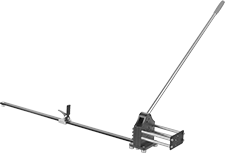Filter by
For Cutting
Length
Number of Mounting Holes
System of Measurement
Height
DIN Rail Trade Size
Handle Length
DFARS Specialty Metals
Export Control Classification Number (ECCN)
Mounting Hole Diameter
REACH
RoHS
Width
DIN-Rail Cutters



DIN 3 Rails with Bracket
Pull the lever on these cutters to make smooth cuts in steel and aluminum DIN rail without leaving a bur. To cut the same length over and over, slide the stop along the ruler and clamp in place. Cutters mount to your workbench.
Mounting Holes | ||||||||||
|---|---|---|---|---|---|---|---|---|---|---|
| For Cutting Trade Size (Height × Depth × Overall Depth) | Height | Width | Length | Handle Length | Ruler Length | Mounting Fasteners Included | Number of | Diameter | Each | |
| DIN 3 Rail (35 × 7.5 mm) DIN 3 Rail (35 × 15 mm) DIN 3 Rail with Bracket (35 × 7.5 × 58 mm) | 47" | 6" | 54" | 40" | 39"/100 cm | No | 4 | 0.39" | 0000000 | 000000000 |

























